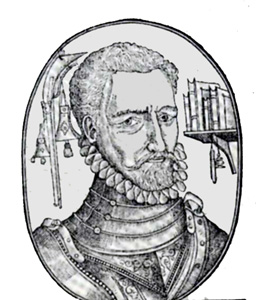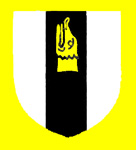George Gascoigne

The only known portrait of George Gascoigne
The Gascoigne family came originally from Yorkshire. They were Lords of the Manor of Cardington from the early 15th century until the late 16th century. George Gascoigne was the eldest son of the Lord of the Manor Sir John Gascoigne and was probably born in Cardington some time between 1535 and 1540.
Bedfordshire and Luton Archives and Records Service has little on the way of documentary evidence of his life other than some legal papers in the Whitbread archive [W]. However, the service a number of articles about him in The Bedfordshire Magazine by Richard S. Smith, Marjorie Weston and L. R. Conisbee, a pamphlet by B. M. Ward and a weighty biography by C. T. Prouty published in New York in 1942. Today Gascoigne is little read but he was an important literary figure at the start of the reign of Queen Elizabeth I (1558-1603).
C. T. Prouty summed up his achievements thus: “He was the first to write an English treatise on poetry, the first to translate a prose comedy from the Italian, the first to put Greek tragedy, even at second hand, on the English stage. The Steele Glas is the first original non-dramatic blank verse in English. The Adventures of F. I. is the first purely English story of the Renaissance, Dan Bartholomew is the first English attempt to tell a love story in s series of poems and in this respect is the predecessor of the flood-tide of Elizabethan sonnet sequences. His masques are amongst the earliest English representations of this type of dramatic art. Finally, The Spoyle of Antwerpe is an early example of news reporting”.
Gascoigne attended Cambridge University and he was admitted to Gray’s Inn as a lawyer in 1555. In 1558 Sir John was Member of Parliament for Bedfordshire and George also attended parliament as Burgess of Bedford Borough. At the coronation of Queen Elizabeth George acted as almoner to the Queen in place of his father, who was ill. It was around this time, presumably, that Gascoigne decided to abandon the law and try to make his way at court. In this he failed, spent all his money and had to return to Bedfordshire in 1563, two years after his marriage to Elizabeth Bacon, then a widow of William Bretton. She had also previously married a man named Edward Boyes and, as she has a considerable fortune Boyes and Gascoigne and their friends came to blows outside her London house. The matter was eventually settled by arbitration.
By 1565 Gascoigne had returned to Gray's Inn but was also writing, including the Greek tragedy Jocasta and a comedy translated from the Italian, Supposes. However, debt and litigation forced him back to Bedfordshire again by 1568. His father died in this year and, before his death, almost disinherited his son. In the event he left his estates to George in his will which was proved on 1st June 1568 [W56]. In the will he expressly states that George was to forfeit the estate if Thomas Colby was “by any ways troubled or molested by my said son for or concerning any lands … which he … hath bought of me and the said George”.
Before the will was even proved George mortgaged the Manor of Cardington, the parsonage and advowson and tithes, the Manor of Fenlake Barns and Haynes Park to Sir George Speke for £540 [W57]. Soon after his father’s death George quarrelled with his brother John over the ownership of this rectory and tithes. A conveyance of 9th May 1569 of Cardington Manor to Speke [W58] notes that George was supposed to have made payments under his father’s will but had not done so “but suffered the said William Curson in danger to be outlawed”. Curson was his father’s sole executor. It was noted that George Gascoigne was then living at Walthamstow [Essex]. In 1570 Speke paid £600 to George Gascoigne [W61].
About this time Gascoigne faced legal action over his tenancy of the manor of Willington. The owner was known to be weak in the head, and Gascoigne seems to have taken advantage of this. This need for money, engagement in sharp practice, non payment of debts and tendency to quarrel show that Gascoigne was certainly not the most pleasant of men.
By 1570 Gascoigne’s lavish lifestyle and cost of numerous law suits sent him to Bedford Gaol for a debt owed to the Earl of Bedford. In 1572 Gascoigne volunteered with alacrity to join the Protestant rebellion against the Spanish in the Netherlands, becoming a soldier of fortune. He joined a group of English soldiers under Sir Humphrey Gilbert. Gilbert’s campaign was a farce, however, and by the year’s end Gascoigne was back in England.
Gascoigne now approached Lord Grey of Wilton to become his patron as he decided that the road to fame and fortune lay in his poetry. As he was assembling his works for publication he went back to Holland in 1573. It may be that a letter sent to the Privy Council by one of his many enemies or creditors lay behind this. The letter survives and denounces him as “a defamed person”, “a common Rymer”, “a notorious Ruffiane” and, much more dangerously, “An Atheist and Godlesse personne”.
This campaign went no better than the first and Gascoigne was captured by the Spanish. He was released in 1574 and, as he put it, “home we came as children come from schoole”.
Perhaps belief in his atheism was widespread. His works had been published while he was away as A Hundreth Sundrie Flowers but was banned at the urging of the religious men in the Court of High Commission. Gascoigne publicly repented and premised to be a good boy in future and, sure enough, his last few works are of an improving nature and included attract against drunkenness called A delicate Diet for Daintiemouthed Drookardes. It was dedicated to Sir Lewis Dyve of Bromham.
In 1575 Gascoigne’s star was finally in the ascendant and the Earl of Leicester asked him to compose part of the entertainment for the Queen during her stay at Licester’s Kenilworth Cstle in Warwickshire. He obviously pleased the Queen as in 1576 he was sent as military observer to the Netherlands where he witnessed the sacking of Antwerp in modern Belgium by mutinous Spanish soldiers.
Gascoigne returned home later that year and began writing again. He had less than a year to live, however, dying on 7th October 1577 at Stamford in Lincolnshire, aged about forty. He may have caught some debilitating disease such as malaria during his time in the Netherlands. Les than ten years after his death this man, who might well be seen as a failure in many ways was described by William Webbe as: “the very cheese of our late rhymers”.
Research by L. R. Conisbee shows that Gascoigne left a son by his wife Elizabeth. His friend George Whetstone, at whose Stamford house he died, refers to a son in some verse he left as a tribute to his dead friend. He was probably the William, son of George Gascoigne, who died in a voyage with Sir Francis Drake in 1585 or 1586 when he would have been in his late teens. Vice admiral of the voyage was Martin Frobisher, a relation of the Gascoigne family.
 The Gascoigne family coat of arms
The Gascoigne family coat of arms